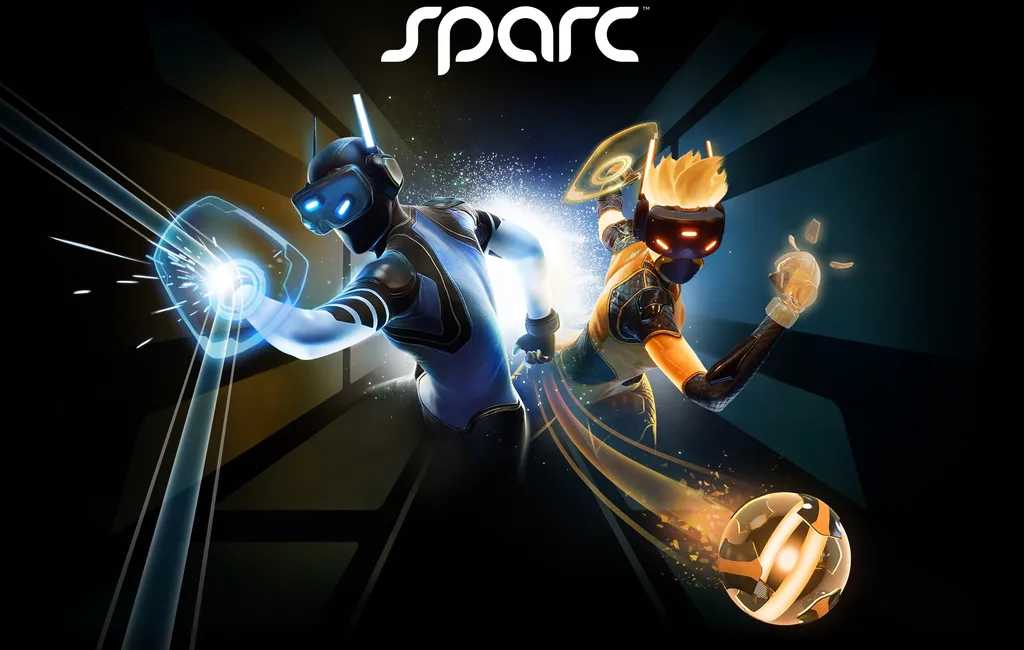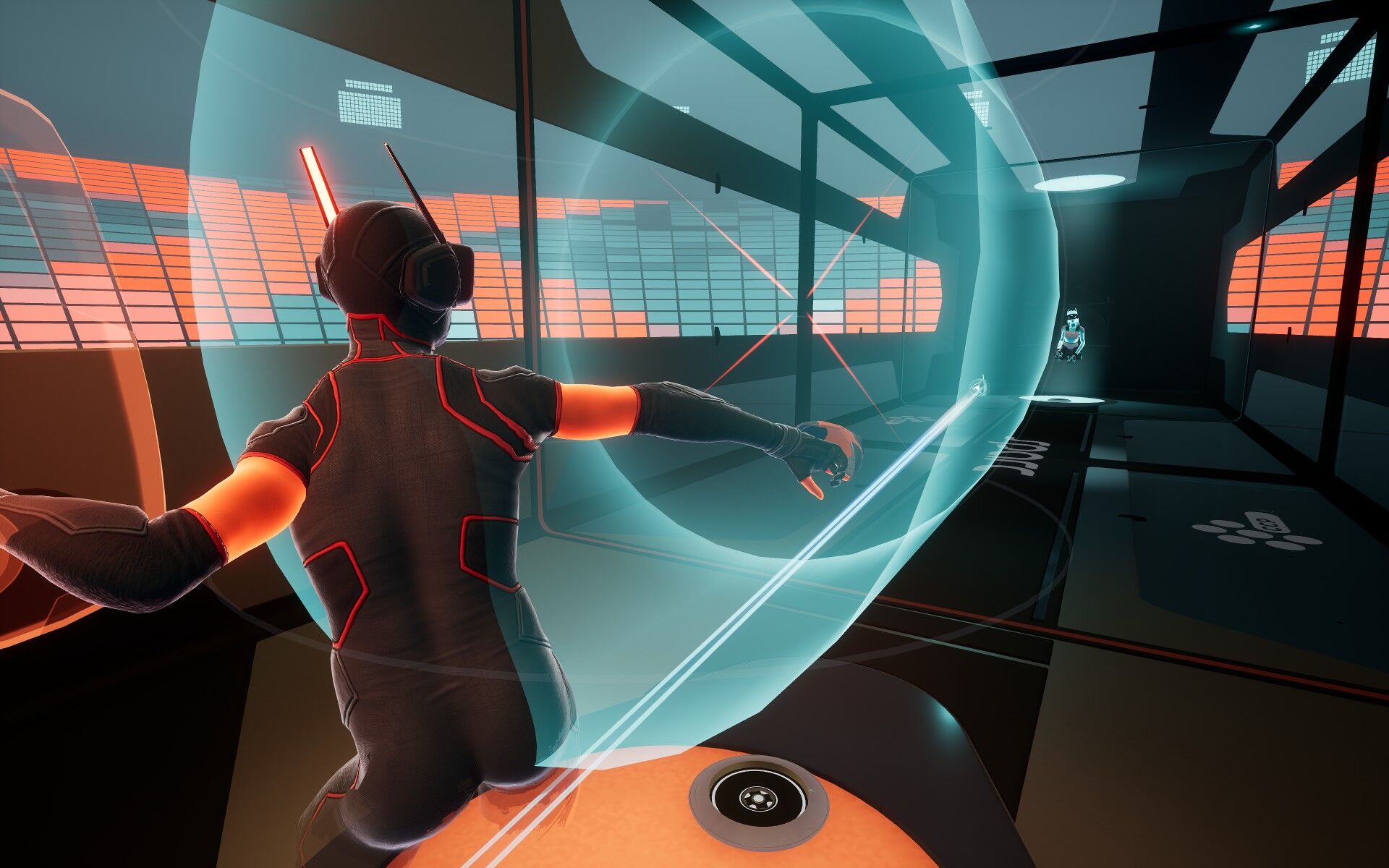The first time we played Sparc from CCP Games it evoked a very specific feeling. As a kid that grew up watching tons of cartoons, anime, and nerdy sci-fi movies, I was obviously familiar with Tron from an early age. Just the idea of getting sucked into a computer and facing off against digital adversaries was super exciting. If you’ve ever felt the same way then you’re going to find a lot to love with Sparc.
However, instead of throwing discs in Sparc like participants do in Tron, this time you’re lobbing orbs at opponents. It’s all about competitive multiplayer and you’ll need to spend a lot of time honing your skills, perfecting your aim, and doing everything you can to hit your enemy with a well-placed toss. It sounds simple, but it’s exhilarating in practice.
From a pure features and content perspective it seems like, at first glance, that there isn’t a whole lot going on with Sparc. At the Main Menu you can customize your character, complete time-based challenges, and compete online. That’s really all there is. CCP Games didn’t include AI opponents for you to face and there are only three different game modes online that are all very similar to one another. Sparc more than makes up for the lack of breadth though with one of the most visceral and intense multiplayer VR games I’ve played to date.
We’ve gone hands-on with Sparc on multiple occasions in the past — even once using the Oculus Touch controllers before it was announced as a timed exclusive for PlayStation VR. Comparatively the game did look a bit better and have better tracking on the PC-powered headset, but it holds up surprisingly well on PSVR in its own right.
During my review I spent a lot of time in the Challenge missions trying to get the best time for the leaderboard and took to the online arena to face off against Tal Blevins, Editor-in-Chief of UploadVR, and Tyler Treese, Senior Editor at PlayStation Lifestyle. Notably, all three of us were surprised by how well the Move controllers performed during our sessions.
When playing online you’re first loaded into a spectator position as you peer down at the arena below you. As two other participants face off against one another you and everyone else must watch from the sidelines. It seems like it’d be boring, but it’s actually one of my favorite features. If someone from the sidelines talks then it reverberates in the arena as if the voice came from an intercom speaker. Players inside the arena can look up and see the spectators towering above them, which is incredibly intimidating. As a spectator you have a great view of the action, which is helpful if your lobby decides to pit new players against the winners of each round.
Then once you zoom down into the arena itself is when the real magic happens. There are three core game modes as of now: Basic, Advanced, and Experimental. Regardless of which game mode you pick the main objective is always the same: hit your opponent. Typically you do this by throwing your ball and hitting their head, arms, or torso (legs aren’t represented inside the world of Sparc.) When your opponent throws their orb at you, you can dodge out of the way by physically ducking and shifting your body, or you can deflect it with your shield. Balls that hit the back wall are sent back via brief teleport, so your back is always safe. The catch though is that your shield only works if you’re holding your ball and you only get one deflection per charge. The only way to recharge is to throw your ball.
If you miss your opponent but still land the ball inside their “Strike Zone” behind them, then your ball grows in size and gets a little faster. Once you score a hit, all your strikes are reset. That’s really the entire game. Everything else is about positioning, angling the ball to bounce off walls, and strategizing the best way to score points.
One of the best strategies I found, if you can time it correctly, is to deflect the opponent’s ball with your shield back at them (you can score points by hitting opponents with their own balls) and then throwing your ball at the same time. This gives them two projectiles to dodge. If your aim is good enough, you can potentially make it impossible for them to avoid both at the same time.
The three game modes do differ slightly as well. For Basic it’s a timed three minute match that awards a win to whoever has the most points at the end. A tie results in Sudden Death. When playing on Basic you can also clench your fist and punch the opponent’s ball back at them, which is supremely satisfying to pull off. This helps give an extra layer of defense if your shield is spent.
For Advanced matches the rules change to a race of who can score four points first and and there are no punches allowed. This changes the dynamic quite dramatically as playing defense once you have a lead isn’t advisable because the tide can turn too quickly. My experiences showed that most Advanced matches were more a war of attrition than anything, waiting to see who’s stamina and accuracy would falter first.
Finally, the Experimental games are just like Basic matches in terms of rules (complete with punching) but the arena is tilted with more angles to ricochet off of. Just a minor architecture change totally morphs the match and makes it feel completely different.
It would have been amazing if there were more arenas to pick from or match settings to tweak. Changing the gravity, ball speed, or even the shape of the projectile (orb vs. disc for example) would have really helped beef up the content a bit. Not to mention the lack of any AI to practice against feels like a huge missed opportunity.
The Challenge missions do exist to provide a bit of fun outside of online matches, but not much. They exist in three varieties: target practice (throwing orbs at targets,) deflection ranges (deflecting orbs with your shield back at targets,) and combined courses with both target practice and deflection ranges alternating. That’s it. The leaderboards are all based on speed, so they’re a fun distraction, but offer little in the face of online competition.
Sparc is an immensely exciting game that excels by honing in on its core mechanic and perfecting it. Fans of Tron’s disc battle premise will find a lot to love here and I could easily see myself losing dozens of hours to digital arena battles with my trusty orb in hand. The lack of AI to play against offline and the absence of many additional arenas or match customization options is a bummer, but the excitement of online play more than makes up for it.
Update: The PC VR version of this game on Rift and Vive is the same as the PSVR version in terms of content, but features improved tracking and slightly better visuals. Playing with Touch in-hand and a 2-3 sensor setup is absolutely better than PSVR. Not enough to change the score itself since it does work fine on Sony’s headset too, but it’s enough of a difference to sway you if you own both headsets.
Sparc is now available for purchase on the PSN Store for PSVR at the price point of $29.99 or on Steam for Rift and Vive for $19.99.. Check out these official review guidelines to find out more about our process.



























